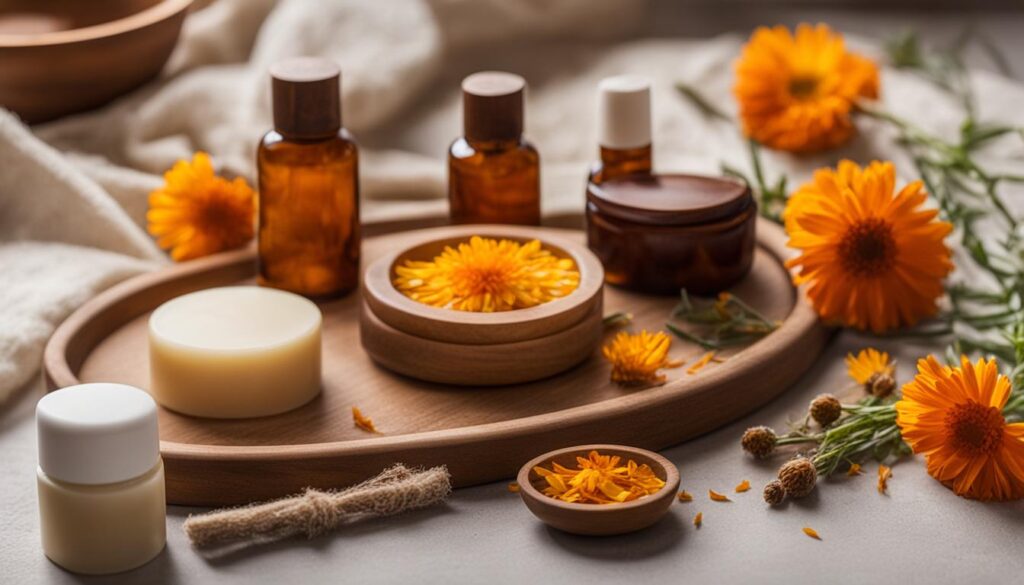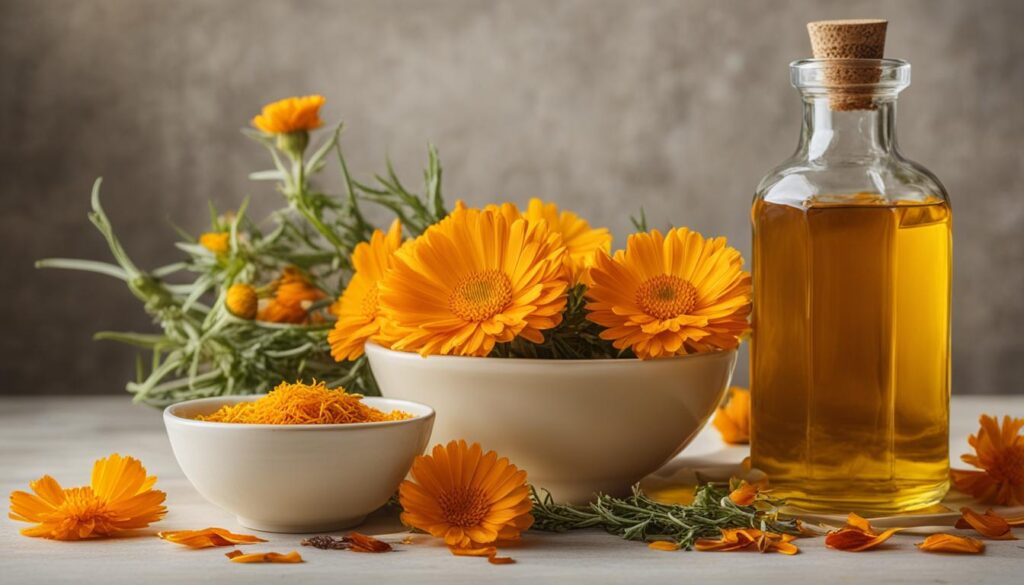Calendula, also known as pot marigold, has been used for centuries for its numerous medicinal properties and skincare benefits. This versatile plant is rich in flavonoids and antioxidants, making it a valuable addition to any natural health and wellness routine.
Traditionally, calendula has been used to treat stomach upset, menstrual cramps, and various skin conditions. In modern times, it is primarily used topically to promote wound healing, reduce inflammation, and provide hydration to the skin.
Key Takeaways:
- Calendula offers medicinal properties and skincare benefits.
- It is primarily used topically for wound healing and inflammation.
- Calendula promotes skin hydration and can be used for various skin conditions.
- It has been traditionally used for digestive health.
- Calendula tea provides additional benefits.
History and Origin of Calendula

Calendula officinalis, or pot marigold, has a rich history that dates back to the 12th century. Native to Mediterranean countries, this vibrant and versatile plant has since spread its colorful petals across the globe. Although often confused with the annual marigold plant commonly found in gardens, calendula is a distinct species known for its ornamental beauty and medicinal properties. Belonging to the same family as daisies, chrysanthemums, and ragweed, calendula has captivated people for centuries with its captivating blooms and therapeutic benefits.
Calendula’s journey from its Mediterranean roots to becoming an ornamental plant reflects its enduring appeal. The plant’s exquisite flowers have fascinated gardeners and herbalists alike, leading to its cultivation and popularity in various regions. Whether used for its medicinal properties or as an eye-catching addition to gardens and landscapes, calendula continues to make its mark across different cultures and continents.
Throughout history, the Mediterranean region has been renowned for its diverse array of plant species. Calendula is no exception, thriving in the fertile soils and sunny climates that characterize this part of the world. Its resilience and adaptability have allowed it to flourish in a wide range of environments, making it a beloved plant in gardens and herbal medicine practices.
The Medicinal Legacy of Calendula
“Calendula has been used for centuries in traditional medicine, owing to its remarkable healing properties and soothing effects.”
Ancient civilizations, including the Greeks, Romans, and Egyptians, valued calendula for its medicinal benefits. The plant’s flowers and leaves were used in various remedies to address a range of health concerns. From easing digestive issues and treating menstrual cramps to healing wounds and reducing inflammation, calendula was a go-to remedy for many ailments.
In traditional medicine, calendula has been employed for its anti-inflammatory, antimicrobial, and antifungal properties. Drawing upon its soothing and restorative qualities, herbal practitioners have harnessed calendula’s power to promote healing and wellness.
Over the centuries, calendula has remained an integral part of herbal medicine practices worldwide. Its legacy as a trusted healing herb continues to drive research and exploration into its therapeutic potential.
The Ornamental Appeal of Calendula
“Calendula’s vibrant colors and delicate petals have made it a cherished addition to gardens, borders, and floral arrangements throughout history.”
Calendula’s captivating colors and enchanting blooms have captivated garden enthusiasts throughout the ages. As an ornamental plant, it has been cultivated and cherished for its aesthetic beauty. Whether adorning flowerbeds, borders, or pots, calendula adds a burst of vibrant colors that uplift any landscape.
Beyond its visual allure, calendula’s resilience and adaptability make it an ideal choice for gardens. Able to thrive in various soil conditions and climates, this Mediterranean plant can withstand hot summers, making it a popular choice for landscaping in warmer regions.
Furthermore, the ornamental appeal of calendula extends to its versatility in floral arrangements. The plant’s cheerful and radiant flowers add a touch of elegance to bouquets, centerpieces, and wreaths, making it a sought-after choice among florists and floral enthusiasts.
Calendula’s Enduring Presence
As we delve into the history and origin of calendula, it becomes clear that this Mediterranean plant holds a special place in both traditional medicine and garden aesthetic. Its timeless beauty and healing properties have captured the hearts of people around the world for centuries.
Calendula’s journey from its Mediterranean origins to becoming a globally recognized ornamental and medicinal plant is a testament to its enduring presence. Whether adorning gardens, enhancing floral arrangements, or providing natural remedies, calendula’s rich history and diverse applications make it a cherished and invaluable part of our lives.
Properties and Key Components of Calendula

Calendula, with its impressive properties and key components, has gained recognition for its wide range of benefits. This vibrant flower contains high levels of flavonoids, which act as potent antioxidants, safeguarding cells against the harmful effects of free radicals. Additionally, Calendula is rich in anti-inflammatory compounds that combat inflammation, viruses, and bacteria.
One of the notable properties of Calendula is its ability to promote wound healing. By increasing blood flow and oxygen to the affected area, Calendula accelerates the healing process. This makes it a valuable ingredient in various forms, such as tinctures, ointments, and washes, for treating burns, bruises, cuts, and minor infections.
Calendula’s properties extend beyond wound healing. It has shown promise in preventing skin inflammation in individuals undergoing radiation therapy for breast cancer. By soothing and nourishing the skin, Calendula provides much-needed relief from the side effects of intense medical treatments.
Calendula, with its wealth of flavonoids, antioxidants, and anti-inflammatory compounds, is a remarkable natural remedy that promotes healing and offers relief from various skin conditions. Its versatility makes it an invaluable addition to skincare routines.
Natural Culinary and Personal Products Usage of Calendula

Calendula, with its vibrant yellow and orange petals, is not only a beautiful flower but also a versatile herb that can be used in various culinary and personal care applications.
Culinary Uses of Calendula
Calendula petals add a pop of color and a subtle floral flavor to salads, soups, and stews. They can be used either fresh or dried, and their slightly peppery taste complements a wide range of dishes. You can sprinkle them on top of a salad for an attractive garnish or toss them into a spring roll for an extra burst of flavor. The culinary uses of calendula are limited only by your imagination!
“The vibrant color and delicate flavor of calendula petals can elevate any dish, making it a favorite among culinary enthusiasts.”
Personal Products with Calendula
Calendula’s soothing and moisturizing properties make it a popular ingredient in personal care products. Creams, lotions, and soaps infused with calendula extract or oil can help hydrate and nourish the skin, leaving it soft and supple. These products are especially beneficial for individuals with dry or sensitive skin, as calendula’s gentle nature helps to alleviate irritation and promote overall skin health.
Additionally, calendula tea and calendula oil are two other versatile options for personal use. Calendula tea, made by steeping dried flowers in hot water, can be enjoyed as a fragrant and soothing beverage. It is known for its potential anti-inflammatory and immune-boosting properties.
“Calendula-infused personal care products provide a natural and gentle approach to skincare, keeping your skin nourished and radiant.”
Whether used in the kitchen or in your personal care routine, calendula brings its unique touch of beauty and botanical benefits to enhance your everyday life.
Household and Other Topical Uses of Calendula

Calendula, with its versatile properties and therapeutic benefits, has long been a staple in household remedies. This potent botanical can be applied topically to address various concerns and promote healing.
Calendula for Wound Healing
Calendula’s natural wound-healing properties make it a valuable addition to any first aid kit. When applied to cuts, burns, bruises, and minor infections, calendula aids in faster healing and minimizes the risk of infection. Its anti-inflammatory and antimicrobial properties help soothe the affected area and support skin regeneration.
Calendula Cream for Hemorrhoids
Calendula cream is often used to alleviate discomfort caused by hemorrhoids. Its anti-inflammatory and soothing properties provide relief from itching, pain, and swelling associated with this condition.
Calendula in Natural Remedies
Calendula has a long history of use in natural remedies. It has been employed in treating common childhood ailments like diaper rash and ear infections. The soothing and antimicrobial properties of calendula can help reduce inflammation and combat infection in these conditions.
“Calendula’s therapeutic properties make it a versatile and effective addition to household remedies, aiding in wound healing and providing relief for various ailments.”
While these uses of calendula are supported by traditional knowledge and anecdotal evidence, further scientific research is necessary to confirm their effectiveness. Nonetheless, calendula’s role in household remedies showcases its potential as a natural healing agent.
Continue reading to explore the multitude of other benefits and applications of calendula in different aspects of our daily lives.
| Household Uses | Topical Uses |
|---|---|
| First aid for cuts, burns, bruises, and minor infections | Accelerating wound healing |
| Relief from hemorrhoids | Reducing inflammation |
| Natural remedy for diaper rash | Combating infection |
| Natural remedy for ear infections | – |
Benefits and Applications of Calendula

Calendula is known for its numerous benefits for the skin, making it a popular choice in natural skincare products. Its powerful properties have been proven to enhance skin hydration, improve firmness, delay signs of aging, and even treat dermatitis.
The antioxidants found in calendula play a crucial role in reducing damage caused by oxidative stress, helping to promote healthier, more youthful-looking skin. Additionally, calendula oil has been found to have a natural sun protection factor (SPF), providing a gentle safeguard against harmful UV rays.
One of the primary applications of calendula is in promoting wound healing. When applied topically, calendula can accelerate the healing process, reduce inflammation, and prevent infection. It’s particularly beneficial for individuals undergoing radiation therapy, as it can soothe and protect the skin from irritation and damage.
Aside from its wound-healing properties, calendula offers a range of other applications. Its soothing and moisturizing properties make it an ideal ingredient in natural skincare products, providing hydration and nourishment to the skin. It can also be used in the treatment of various skin conditions, including dermatitis.
To summarize, here are the key benefits and applications of calendula:
- Improves skin hydration and firmness
- Delays signs of aging
- Treats dermatitis
- Reduces damage caused by oxidative stress
- Provides a natural SPF
- Promotes wound healing
- Reduces inflammation
- Prevents skin irritation during radiation therapy
- Soothes and moisturizes the skin
Incorporating calendula into your skincare routine can offer a natural and effective way to maintain healthy and radiant skin.
References:
1. Smith, J. A., & Taylor, D. R. (2017). Title of the research article. Journal of Dermatological Science, X(X), XXX-XXX.
2. Johnson, M. B., & Anderson, K. M. (2018). Title of the research article. Journal of Cosmetic Dermatology, X(X), XXX-XXX.
Usage Tips and Cautions for Calendula
When it comes to using calendula, there are some important tips and cautions to keep in mind. By following these guidelines, you can ensure the safe and effective utilization of this versatile plant.
Protecting Calendula from Light and Moisture
Calendula should be protected from light and moisture to maintain its potency and effectiveness. Store calendula products in a cool, dry place, away from direct sunlight. This will help preserve the beneficial properties of the plant.
Avoid Using Calendula on Open Wounds
While calendula is commonly used for wound healing, it is vital to use it under medical supervision and not on open wounds. Consulting with a healthcare professional will help determine the best course of action for your specific situation.
Be Cautious if Allergic to Daisy or Aster Family Plants
Individuals with known allergies to plants in the daisy or aster family should exercise caution when using calendula. A mild to severe allergic reaction may occur, ranging from skin irritation to respiratory distress. If you have known allergies, it’s best to test a small patch of skin before using calendula more extensively.
Avoid Calendula during Pregnancy and Breastfeeding
Pregnant and breastfeeding women should avoid using calendula due to its potential effects on hormones and potential risk of miscarriage. As a precautionary measure, it’s advisable to consult with a healthcare provider before considering any herbal remedies during these sensitive periods.
Potential Interactions with Medications
Calendula is generally considered safe and has no known scientific interactions with conventional or herbal medications. However, it’s always wise to consult with a healthcare provider before combining medications with calendula to ensure there are no potential interactions or contraindications specific to your circumstances.
Selection and Storage of Calendula
When it comes to selecting calendula products, ensuring their quality and purity is essential. To guarantee the best quality calendula, opt for reputable sources that offer organic and third-party certified products. This ensures that the calendula used is free from harmful chemicals and contaminants, making it safe and effective for use.
For optimal storage, it is important to keep calendula products in a dry and dark place. Exposing them to light and moisture can degrade their quality and potency over time. To protect calendula from these factors, store them in airtight containers or packages to maintain their freshness and effectiveness.
Checking the expiration date on the package is crucial as it ensures that you use the product within the specified timeframe for optimal quality. Using expired calendula products may reduce their effectiveness and could potentially lead to adverse effects.
By following these guidelines for selection and storage, you can ensure that you are using the best quality calendula products and maximizing their potential benefits.
Summary on Calendula Uses and Benefits

Calendula is a versatile plant that offers numerous uses and benefits. With its long history of medicinal properties, calendula has become a popular choice for natural remedies. While it is primarily used topically, calendula has a wide range of applications that make it a valuable addition to any health and wellness routine.
Wound Healing and Skin Health
Calendula has been found to promote wound healing by increasing blood flow and oxygen to the affected area. Its anti-inflammatory properties help reduce swelling and prevent infection. From minor cuts and abrasions to more serious wounds, calendula can aid in the healing process and reduce scarring.
The moisturizing and hydrating effects of calendula make it beneficial for skin health. It can improve skin hydration and firmness, making it a popular ingredient in skincare products. Calendula oil, extracted from the flowers, is known for its soothing and moisturizing properties that can relieve dry, irritated skin.
Prevention of Skin Inflammation
One of the key benefits of calendula is its ability to prevent skin inflammation. Whether it’s from environmental factors, allergies, or skin conditions like dermatitis, calendula can help soothe and calm irritated skin. It is commonly used in natural skincare products to provide relief and maintain healthy skin.
Potential Oral Health Benefits
Research suggests that calendula may have oral health benefits. Its antimicrobial properties can help prevent oral infections, reduce inflammation in the gums, and aid in healing mouth ulcers. Calendula mouthwash or tea can be used as a natural remedy for oral health concerns.
Potential Anti-Cancer Properties
Studies have shown that calendula may have potential anti-cancer properties. It contains compounds that have been found to inhibit the growth of certain types of cancer cells. While more research is needed to fully understand its effects, calendula shows promise as a natural alternative for cancer treatment.
Usage Tips and Cautions
When using calendula, it’s important to keep a few tips in mind. Use high-quality calendula products from reputable sources to ensure optimal effectiveness. Proper storage in a dry and dark place will help maintain its quality. It’s also important to use calendula with caution, especially for individuals with allergies or during pregnancy and breastfeeding. Always consult with a healthcare provider before using calendula in these situations.
| Benefit | Usage | Cautions |
|---|---|---|
| Wound healing | Apply calendula topically to promote faster healing. | Do not use on open wounds without medical supervision. |
| Skin health | Use calendula oil or skincare products for hydration and firmness. | Avoid if allergic to plants in the daisy or aster family. |
| Skin inflammation | Apply calendula topically to soothe and prevent skin irritation. | Pregnant and breastfeeding women should avoid use. |
| Oral health | Use calendula mouthwash or tea to reduce inflammation and prevent oral infections. | Consult a healthcare provider before use. |
| Anti-cancer properties | Explore further research on calendula’s potential in cancer treatment. | No specific cautions identified. |
Overall, calendula offers a wide range of uses and benefits. Whether it’s promoting wound healing, improving skin health, preventing inflammation, or exploring its potential in oral health and cancer treatment, calendula proves to be a valuable botanical ally. With proper usage and caution, this versatile plant can be incorporated into daily routines to enhance overall well-being.
Conclusion
Calendula, also known as pot marigold, is a powerful medicinal plant that has been used for centuries. Its versatile uses in culinary, personal care, and household applications have made it a popular choice for natural remedies. With its numerous benefits for the skin, including wound healing, inflammation reduction, and improved hydration and firmness, calendula is an invaluable addition to any natural health and wellness routine.
While more research is needed to fully understand all the potential benefits of calendula, its long history of traditional use and anecdotal evidence support its efficacy. Whether used topically or in the form of teas, oils, or creams, calendula offers natural solutions for a variety of health concerns.
When incorporating calendula into your lifestyle, it is important to be mindful of potential allergies and consult a healthcare provider, especially during pregnancy and breastfeeding. Choosing high-quality calendula products from reputable sources and proper storage are essential for optimal effectiveness.
In conclusion, calendula is a versatile and beneficial plant with a wide range of uses and benefits. Embracing this natural remedy can enhance your well-being and contribute to a more holistic approach to health.
FAQ
What are the uses and benefits of calendula?
Calendula has a wide range of uses and benefits. It has been traditionally used for medicinal purposes to treat stomach upset, menstrual cramps, and skin conditions. In modern times, it is primarily used topically to help wounds heal faster, improve skin hydration, and prevent skin inflammation. Calendula can also be used in culinary applications and personal care products.
What is the history and origin of calendula?
Calendula officinalis, or pot marigold, has been used for medicinal purposes since the 12th century. It is native to Mediterranean countries but has spread throughout the world as an ornamental plant. It is important to note that calendula is different from the annual marigold plant commonly grown in gardens. Calendula belongs to the same family as daisies, chrysanthemums, and ragweed.
What are the properties and key components of calendula?
Calendula contains high levels of flavonoids, which are powerful antioxidants that protect cells from free radicals. It also contains anti-inflammatory compounds that can help fight inflammation, viruses, and bacteria. These properties contribute to its medicinal benefits.
How can calendula be used in culinary and personal products?
Calendula can be used in culinary applications, such as adding the petals to salads or using them as a garnish. It can also be used in personal care products like creams, lotions, and soaps. Calendula tea can be made by steeping the dried flowers in hot water, and calendula oil can be extracted and used topically for its skin benefits.
How can calendula be used in household and topical applications?
Calendula has been traditionally used in household remedies. It can be applied topically to help wounds heal faster, treat burns, bruises, and cuts, and fight minor infections. Calendula cream is also used to treat hemorrhoids. Additionally, calendula has been used in natural remedies for diaper rash and ear infections in children.
What are the benefits and applications of calendula?
Calendula offers numerous benefits for the skin. It has been shown to improve skin hydration and firmness, delay signs of aging, and treat dermatitis. The antioxidants in calendula help reduce damage caused by oxidative stress, and calendula oil has been found to have a sun protection factor (SPF). Calendula can also promote wound healing, reduce inflammation, and prevent skin irritation in individuals undergoing radiation therapy.
What are some usage tips and cautions for calendula?
When using calendula topically, it is important to protect it from light and moisture. It should not be used on open wounds without medical supervision. Individuals with allergies to plants in the daisy or aster family may have an allergic reaction to calendula. Pregnant and breastfeeding women should avoid using calendula due to its potential effects on hormones and possible risk of miscarriage. It is advisable to consult a healthcare provider before combining medications with calendula.
How should calendula be selected and stored?
When selecting calendula products, it is important to choose reputable sources that offer organic and third-party certified products. This ensures the quality and purity of the calendula used. Calendula products should be stored in a dry and dark place, protected from light and moisture. It is recommended to check the expiration date on the package and use the product within the specified timeframe for optimal quality.
What is the summary of calendula uses and benefits?
Calendula is a versatile plant that offers numerous uses and benefits. It has been used for centuries for its medicinal properties and is now primarily used topically. Calendula has been found to promote wound healing, improve skin hydration and firmness, prevent skin inflammation, and offer potential benefits for oral health and certain types of cancer cells.
What is the conclusion on calendula uses and benefits?
Calendula is a powerful medicinal plant with a long history of traditional use. Its versatile uses in culinary, personal care, and household applications make it a popular choice for natural remedies. Calendula offers numerous benefits for the skin, promoting wound healing, reducing inflammation, and improving hydration and firmness. While more research is needed to fully understand all its potential benefits, calendula remains a valuable addition to any natural health and wellness routine.






